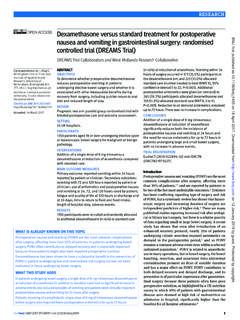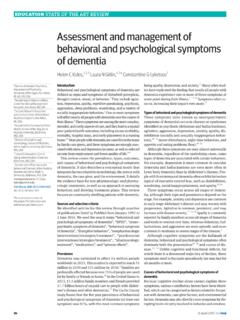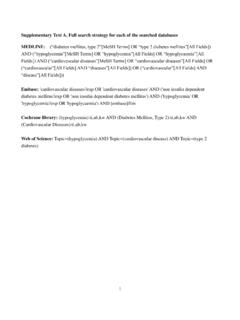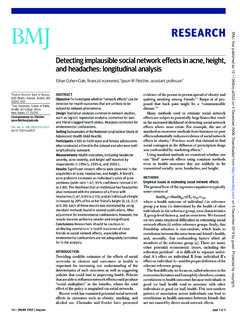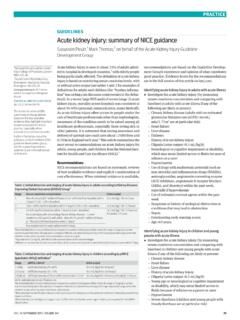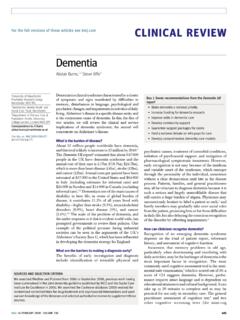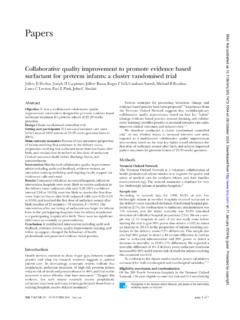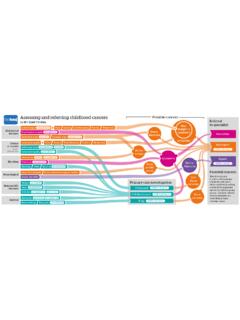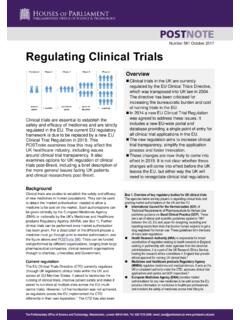Transcription of Choice of implant combinations in total hip …
1 The bmj | BMJ 2017;359:j4651 | doi: 1 RESEARCHC hoice of implant combinations in total hip replacement: systematic review and network meta-analysisJos A L pez-L pez,1 Rachel L Humphriss,1 Andrew D Beswick,2 Howard H Z Thom,1 Linda P Hunt,2 Amanda Burston,2 Christopher G Fawsitt,1 William Hollingworth,1 Julian P T Higgins,1 Nicky J Welton,1 Ashley W Blom,2 Elsa M R Marques2 ABSTRACTOBJECTIVETo compare the survival of different implant combinations for primary total hip replacement (THR). DESIGNS ystematic review and network meta-analysis. DATA SOURCESM edline, Embase, The Cochrane Library, , WHO International clinical Trials Registry Platform, and the EU clinical Trials METHODSP ublished randomised controlled trials comparing different implant combinations . implant combinations were defined by bearing surface materials (metal-on-polyethylene, ceramic-on-polyethylene, ceramic-on-ceramic, or metal-on-metal), head size (large 36 mm or small <36 mm), and fixation technique (cemented, uncemented, hybrid, or reverse hybrid).
2 Our reference implant combination was metal-on-polyethylene (not highly cross linked), small head, and cemented. The primary outcome was revision surgery at 0-2 years and 2-10 years after primary THR. The secondary outcome was the Harris hip score reported by studies were included in the systematic review, and 15 studies (3177 hips) in the network meta-analysis for revision. There was no evidence that the risk of revision surgery was reduced by other implant combinations compared with the reference implant combination. Although estimates are imprecise, metal-on-metal, small head, cemented implants (hazard ratio , 95% credible interval to ) and resurfacing ( , to ) increase the risk of revision at 0-2 years after primary THR compared with the reference implant combination. Similar results were observed for the 2-10 years period. 31 studies (2888 patients) were included in the analysis of Harris hip score.
3 No implant combination had a better score than the reference implant implant combinations were not found to be better than the reference implant combination (metal-on-polyethylene (not highly cross linked), small head, cemented) in terms of risk of revision surgery or Harris hip score. Metal-on-metal, small head, cemented implants and resurfacing increased the risk of revision surgery compared with the reference implant combination. The results were consistent with observational evidence and were replicated in sensitivity analysis but were limited by poor reporting across REVIEW REGISTRATIONPROSPERO CRD42015019435. IntroductionTotal hip replacement (THR) is one of the most common surgical procedures performed worldwide. In England, Wales, and Northern Ireland, the National Joint Registry recorded that 796 636 THRs were performed between 2003 and In the USA an estimated million people are living with a hip The main indications for elective THR are pain and functional limitations owing to a primary THR, both the acetabulum and the femoral head are replaced: a metal stem is inserted into the femur with a modular head that articulates with an artificial cup, the acetabular component (metal-on-polyethylene).
4 The most widely used combination of these bearing surfaces comprises a metal femoral head and a polyethylene acetabular cup. It was developed by Sir John Charnley and has been in use since the early Long term survival of these early implants was good, with around 77-81% not needing revision 25 years after primary An alternative to primary THR is resurfacing hip replacement, in which the acetabulum is replaced with a metal cup, and the femoral head is trimmed and capped with a surface replacement femoral prosthesis. In England and Wales, the use of resurfacings has declined, from of hip replacements in 2006 to less than 1% in With the increasing use of THR in younger and more active patients where revision rates are higher,6 and concerns about the role of polyethylene wear particles in osteolysis and loosening,5 new bearing surface materials were implants have four main combinations of femoral head and acetabular bearing surface materials: 1 Department of Population Health Sciences, Bristol Medical School, University of Bristol, Bristol, UK2 Musculoskeletal Research Unit, University of Bristol, Southmead Hospital, Learning and Research Building (Level 1), Bristol BS10 5NB, UKCorrespondence to: E M R Marques material is published online only.
5 To view please visit the journal this as: BMJ 2017;359:j4651 : 4 October 2017 WhAT IS AlReAdy knoWn on ThIS TopICObservational evidence using joint registry data suggests that resurfacing hip replacements and metal-on-metal implant combinations fail at a higher rate than metal-on-polyethylene, small head, cemented implantsJoint registry data also suggest that newer ceramic-on-ceramic, large head implant combinations might improve implant survival compared with standard implant combinationsWhAT ThIS STudy AddSA synthesis of randomised evidence suggests that resurfacings and metal-on-metal, small head, cemented implants increase the risk of revision surgery compared with metal-on-polyethylene, small head, cemented implantsThere was no evidence that newer implant combinations , such as ceramic-on-ceramic implants are superior to the metal-on-polyethylene, small head, cemented implants on 10 June 2021 by guest.
6 Protected by : first published as on 2 November 2017. Downloaded from RESEARCH2 doi: | BMJ 2017;359:j4651 | the bmjmetal-on-polyethylene, ceramic-on-polyethylene, ceramic-on-ceramic, or Ceramic-on-metal implants are uncommon. Femoral head sizes vary, typically ranging from mm to 50 mm in diameter. The possible fixation techniques (the method of attaching the bearing surface material to the bone) are cemented (when both components are cemented), uncemented (neither component is cemented), hybrid (the femoral stem but not the acetabular cup is cemented), or reverse hybrid (the acetabular cup but not the femoral stem is cemented). In early studies, implant failure after primary THR was attributed to the use of cement, but there is currently little evidence that implant survival rates are superior using other fixation Figure 1 shows a resurfacing implant ; a ceramic-on-ceramic, large head, uncemented implant ; and a ceramic-on-polyethylene, small head, cemented an implant fails (eg, due to loosening, infection, or dislocation) patients may endure severe pain and disability and require surgical revision.
7 Although the key patient expectations of THR are long term reduction in pain, improvement in function, and participation in recreational interests,5 these outcomes are inevitably linked to implant 10 Joint registries, with extensive records of patients over time,11 play an important role in monitoring the long term performance of implants. An analysis of National Joint Registry data between 2003 and 2011 found higher revision rates for metal-on-metal In registries, implant combinations are selected for patients based on individual characteristics, making comparisons between implant combinations susceptible to bias. Randomised controlled trials overcome the limitation of patient selection but often lack long term follow-up. Systematic reviews and meta-analyses have been conducted,13-16 but they have not provided a complete overview of randomised evidence on combinations of implant materials, or acquired key information from study authors to allow a focus on revision present a systematic review of randomised controlled trial evidence comparing rates of revision surgery, and of doctor assessed and patient assessed outcomes of the various bearing surface materials, head sizes, and fixation techniques ( implant combinations ) used in THR.
8 For the statistical integration of results, we used a network meta-analysis approach, which combines direct and indirect evidence from the implant combinations that are currently available for primary THR. MethodsStudy eligibility and selectionRandomised controlled trials including patients aged 18 years or older with a diagnosis of osteoarthritis in the majority (>50%) of patients, comparing different bearing surface materials (including resurfacing) or head sizes in primary total hip replacement (THR) were eligible. Web appendix 1 shows the possible implant combinations . We categorised head sizes as large ( 36 mm in diameter) or small (<36 mm). Polyethylene materials were further classified as highly cross linked (a newer generation of polyethylene) or not highly cross linked (including conventional polyethylene and other types of polyethylene).
9 We excluded studies of patients receiving simultaneous bilateral THR, emergency surgery, or revision hip primary outcome was first revision surgery after primary THR or resurfacing. The secondary outcomes were the Harris hip score reported by clinicians,17 and the Oxford hip score18 and Western Ontario and McMaster Universities osteoarthritis index score (WOMAC)19 based on patient undertook a systematic search of the literature in February 2015 (updated in July 2016). Web appendix 2 shows the search strategy as applied in Medline. This was tailored to each database, and used in Medline, Embase, and The Cochrane Library. We also searched the clinical trials databases , WHO International clinical Trials Registry Platform, and the EU clinical Trials Register. We checked reference lists of identified studies and tracked citations of key articles in Web of Science.
10 Websites of orthopaedic conferences since January 2012 were examined to identify current unpublished studies. Our searches had no language registered our systematic review prospectively in PROSPERO (CRD42015019435). We formulated the research question according to the PICO (population, intervention, comparison, and outcome) The systematic review methods were based on those recommended by Cochrane,21 and reporting was in accordance with the Reporting Items for Systematic Reviews and Meta-Analyses (PRISMA) Further details of the methods can be found in the published collection and assessment of risk of biasTwo reviewers independently screened titles and abstracts and extracted data from the included studies. They contacted authors of published studies, protocols, and trial register entries for additional information when necessary.
